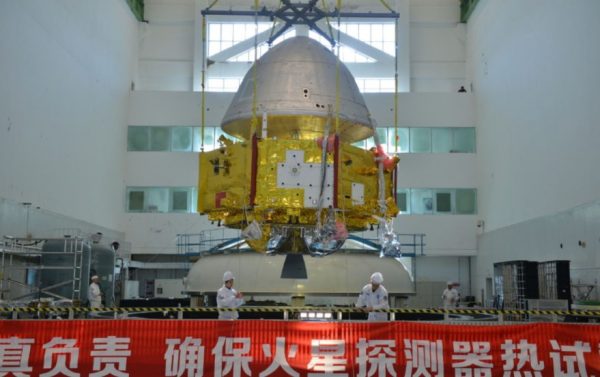Rocket nears spaceport for Chinese space station test launch – SpaceNews
Test flight for low Earth orbit space station to also demonstrate deep space crewed mission capabilities.
HELSINKI — The first flight model of a rocket designed to launch modules for a Chinese space station is set to arrive at Wenchang spaceport for a crucial test mission.
The Long March 5B launch vehicle — including a five-meter-diameter core stage and four side boosters — is due to reach Qinglan port, Hainan island, Feb.1, ship tracking reveals. Specially designed cargo vessels Yuanwang-21 and 22 collected the components at the port city of Tianjin before departing Jan. 26.
The primary goal of the test flight is testing the Long March 5B for launching to low Earth orbit (LEO) in preparation for launch of the core module of China’s space station. A prototype of the roughly 22.5-metric-ton liftoff mass Tianhe core module was delivered to Wenchang earlier in January for integration tests.
The launch will however carry an uncrewed test flight of a new generation crewed spacecraft designed to provide China with greater human spaceflight capabilities.
The as-yet-unnamed spacecraft will be capable of carrying up to six astronauts, or three astronauts and 500 kilograms of cargo. It is also designed to facilitate missions to the moon and deep space. The Shenzhou can carry three astronauts to LEO and has been used of all six of the country’s crewed missions.
The test launch is likely to take place in April following launch preparations at vertical integration facility. The previous missions involving the standard Long March 5 variant took roughly two months from arrival to launch. The Long March 5B mission is proceeding following a successful return-to-flight of the third Long March 5 in late December.
Space station test launch, high-speed reentry
In order to both simulate the launch of a space station module and test the beyond-low-Earth-orbit capabilities of the crewed spacecraft, the spacecraft will carry extra propellant, according to Chinese state media.
“We will use the Long March 5B rocket to launch the space station, which weighs 22 tons. So we will use the weight as a standard for the test launch, using nearly 10 tons of propellant,” Yang Qing, chief designer of the new spacecraft, told CCTV.
Once in low Earth orbit, the two-module, 8.8-meter-long, 21.6-ton uncrewed spacecraft will use its own propulsion to raise its orbit to an apogee of around 8,000 kilometers. It will then attempt a high-speed reentry to test new heat shielding.
The mission profile appears similar in nature to NASA’s 2014 Orion EFT-1 flight. The mission will test avionics, performance in orbit, new heat shielding, parachute deployment, a cushioned airbag landing, and recovery. Planned partial reusability — by replacing the heat shielding — will also be tested.
The test launch is the first of numerous launches required to construction the planned three-module.
“China has planned about 12 flight missions for the construction of China’s space station. The first flight mission of Long March-5B rocket is also to verify its performance,” Hao Chun, director of the China Manned Space Engineering Office, told state media.
Launches of modules, Tianzhou cargo and refueling craft and crewed Shenzhou missions make up the flight list.
Mars, moon, core module schedule
Two flights of the standard Long March 5, which is used for higher orbits, are planned in 2020. The first, in late July, will launch China’s first mission to Mars. A second will send the Chang’e-5 lunar sample return spacecraft toward the moon around late October. Launch of the Tianhe core module could follow this, in early 2021.
Chang’e-5 was originally scheduled to launch in late 2017. However the failure of the second Long March 5 in July that year delayed that and China’s space station. The new schedule follows the successful third flight Dec. 27.
Preparations for the Mars launch, also China’s first independent interplanetary mission, are well underway. The YF-77 hydrolox engines for the Long March 5 came through a 100-second ground test Jan. 19.
The final space environment tests for the five-ton spacecraft, which consists of both an orbiter and a rover, are being carried out in Beijing. The spacecraft will be sent to Wenchang following completion of thermal-vacuum tests on the 240-kilogram solar-power rover.

Civil ChinaChinese space stationLong March 5MarsWenchang Hainan






